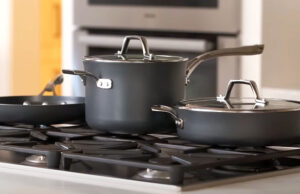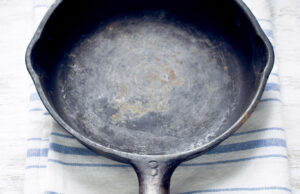Aluminum foil is a kitchen essential for many people, but should you really use it in the oven? It’s something we often reach for without thinking, but is it safe? What are the pros and cons? In this article, we’re diving deep into whether using aluminum foil in your oven is a good idea or not. Get ready to discover some surprising facts that might change the way you bake or roast in the future. Let’s get started!
What Is Aluminum Foil, and Why Do We Use It in the Oven?
Aluminum foil is a thin, flexible metal sheet that is widely used in cooking and baking. Its versatility makes it a kitchen staple, and most of us have used it at least once in the oven, whether it’s to wrap food or line a pan. But what exactly is it, and why do we even bother using it in the oven?
Aluminum foil is made by rolling aluminum metal into very thin sheets. It’s lightweight, non-toxic, and an excellent conductor of heat. Because of these properties, aluminum foil is ideal for various cooking purposes, including in the oven. It can reflect heat, trap moisture, and even protect your food from direct exposure to heat, which helps it cook more evenly.
People use aluminum foil in the oven for different reasons:
- Preventing Food from Overcooking: Wrapping food in aluminum foil helps lock in moisture and ensures it doesn’t dry out, making it perfect for dishes like roasted chicken or baked potatoes.
- Even Cooking: The foil helps distribute heat more evenly around your food, allowing it to cook consistently on all sides.
- Preventing Spills: Lining the bottom of your oven or a baking pan with foil can help catch any drips or spills from sauces, keeping your oven clean.
- Wrapping Food: Foil is perfect for wrapping meats or vegetables, making them easy to cook in their own juices, resulting in tender, flavorful meals.
But even though aluminum foil has these great qualities, using it in the oven isn’t always the best idea. There are a few risks involved, and it’s important to know when and how to use it safely.
The Benefits of Using Aluminum Foil in the Oven
While aluminum foil might not be the perfect solution for everything, there are some big benefits to using it in the oven. Here’s why it can be a useful tool for home cooks:
Prevents Drying Out: Wrapping food in aluminum foil helps trap moisture, keeping your food juicy and tender. This is particularly helpful when baking or roasting meats, like chicken, turkey, or beef. If you’re cooking something that tends to dry out quickly, like fish or vegetables, wrapping it in foil can help retain its natural moisture.
Reduces Clean-Up Time: One of the biggest benefits of using foil in the oven is that it makes cleaning up much easier. If you line a baking sheet or tray with foil, any food spills or grease will land on the foil, which you can simply toss away after cooking. This saves you from scrubbing the tray or oven later.
Even Cooking and Heat Distribution: Aluminum foil reflects heat and helps it distribute more evenly throughout the food. This can be especially useful for foods that need uniform cooking, like casseroles or lasagnas. If you’re roasting a whole chicken, wrapping parts of the bird in foil can prevent overcooking the outer layers while ensuring the inside cooks perfectly.
Keeps Food Warm: Aluminum foil is also great for keeping food warm after it’s been cooked. If you need to keep food hot until you’re ready to serve it, simply cover it with a layer of foil, which traps heat and moisture.
Great for Grilling: Aluminum foil can be used to create packets for grilling food. These packets help lock in flavors and moisture, making them ideal for grilling fish, veggies, or even potatoes. This method keeps food juicy and prevents it from sticking to the grill.
How to Use Aluminum Foil Safely in the Oven
Though aluminum foil is highly useful, it’s important to follow a few basic rules to ensure that you’re using it safely in the oven. Here are some tips to help you avoid potential issues:
Avoid Contact with Heat Sources: One of the most common mistakes people make when using aluminum foil in the oven is allowing it to touch direct heat sources like the oven’s heating element. This can cause the foil to catch fire or melt. Always make sure that the foil is used for wrapping or covering food, not placed directly on heating elements or racks.
Use Heavy-Duty Foil for High-Temperature Cooking: Regular aluminum foil is fine for most baking and roasting tasks, but if you’re cooking something at a very high temperature, like broiling or grilling, it’s better to use heavy-duty foil. Heavy-duty foil is thicker and more resistant to tearing or puncturing under extreme heat.
Leave Some Space for Ventilation: If you’re using foil to cover food, make sure to leave some space for steam to escape. If you seal the foil too tightly, steam can build up and potentially cause the foil to burst or the food to cook unevenly.
Don’t Use Foil for Acidic Foods: Acidic foods like tomatoes or citrus can react with aluminum foil, causing a metallic taste and possibly damaging the foil. If you’re cooking something acidic, it’s better to use parchment paper or another non-reactive surface instead of foil.
Check Your Oven’s Manual: Some oven manufacturers discourage or even prohibit the use of aluminum foil in certain areas of the oven, especially on the bottom. Always check your oven’s manual to see if there are any restrictions or warnings about using foil.
By following these safety tips, you can make sure you’re using aluminum foil in a way that enhances your cooking experience rather than causing problems.
Risks and Drawbacks of Using Aluminum Foil in the Oven
While aluminum foil is great for certain tasks in the kitchen, it’s not without its downsides. Here are a few risks and drawbacks to be aware of when using foil in the oven:
Potential for Fire Hazards: One of the biggest risks of using aluminum foil in the oven is the potential for it to catch fire. If the foil comes into direct contact with the oven’s heating element or is used incorrectly, it can overheat and burn, causing a fire hazard. Always make sure that the foil is securely placed and not touching any direct heat sources.
Damage to the Oven: Using aluminum foil on the bottom of your oven or on racks can cause long-term damage. Foil can reflect too much heat, making certain parts of your oven too hot, which could lead to overheating or even warping. Some manufacturers specifically warn against using foil in this way, so it’s always best to check your oven’s user manual.
Food Tastes Can Be Affected: As mentioned earlier, aluminum foil can react with acidic foods, giving them an unpleasant metallic taste. If you’re making a dish with ingredients like tomatoes, vinegar, or citrus, it’s better to avoid using aluminum foil for wrapping or covering the food. Instead, try using parchment paper or another non-reactive covering.
Environmental Concerns: Aluminum foil is not the most environmentally friendly material. After using it, you can recycle it, but in many areas, it may still end up in landfills, contributing to waste. If you’re concerned about the environmental impact, consider using alternatives like reusable baking mats or parchment paper, which are more sustainable.
Health Concerns: Although the evidence is still debated, there are concerns about the potential health risks of using aluminum foil in cooking. Some studies suggest that aluminum can leach into food, especially when cooking at high temperatures or with acidic foods. However, many experts argue that the amount of aluminum that actually leaches into food is minimal and not a major health concern. Nevertheless, if you’re worried about the potential risks, you can always choose to limit your use of aluminum foil in the kitchen.
Final Thoughts
I hope this article helped you understand the pros and cons of using aluminum foil in the oven. It’s a handy tool for many cooking tasks, but it’s essential to use it correctly and safely. If you follow the tips mentioned here, you’ll get the most out of aluminum foil without facing any risks. Happy cooking!
Frequently Asked Questions
Is it safe to use aluminum foil in a convection oven?
Yes, it’s generally safe to use aluminum foil in a convection oven. Just make sure the foil doesn’t block the air vents, as the circulation of air is important for even cooking.
Can aluminum foil be used on the oven rack?
It’s not recommended to place aluminum foil directly on the oven rack. It can reflect heat and cause uneven cooking or potential damage to your oven.
Do I need to use aluminum foil to bake cookies?
No, it’s not necessary to use aluminum foil to bake cookies, but it can help with easy clean-up. You can also use parchment paper as a non-stick alternative.
Is it safe to use aluminum foil to cover a turkey?
Yes, using aluminum foil to cover a turkey while roasting helps keep it moist and prevents overcooking. Just be sure to remove the foil during the last 30 minutes to allow the skin to crisp up.
Can aluminum foil catch fire in the oven?
Aluminum foil can catch fire if it comes into direct contact with the heating element. Always ensure it is placed safely and doesn’t touch any heat source.
Do I need to line the bottom of the oven with aluminum foil?
It’s not recommended to line the bottom of your oven with aluminum foil because it can cause heat to reflect unevenly and may damage the oven. Instead, use a baking sheet.
Is it okay to wrap fish in aluminum foil in the oven?
Yes, wrapping fish in aluminum foil is a great way to retain moisture while baking, helping it cook evenly and remain tender.
Can I reuse aluminum foil after using it in the oven?
You can reuse aluminum foil as long as it’s not too damaged or greasy. Just make sure to clean it before using it again.



